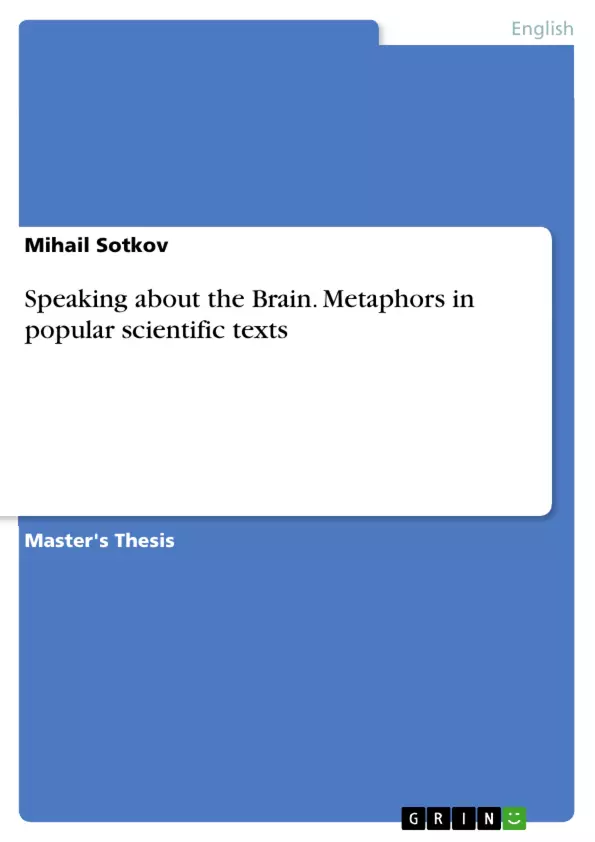This paper deals with metaphorical representations of the human brain (i.e. brain metaphors) in popular scientific texts.
A corpus consisting of forty (newspaper) articles is analysed by applying Fauconnier and Turner's Conceptual Integration Networks (1998, 2002).
The work is embedded in the field of Cognitive Linguistics and tries to offer some insights in how we conceptualise the human brain in popular science, revealing the nature of meaning creation as well as sketching the reciprocal interdependence of the human brain and machines as the predominant popular scientific paradigm of conceptualising human nature.
Inhaltsverzeichnis (Table of Contents)
- Introduction
- Popular scientific texts and Metaphors
- The role of Metaphors
- A short diachronic overview of brain Metaphors
- Linguistic Framework
- Cognitive Linguistics
- Conceptual Metaphor Theory
- Primary Metaphor Theory
- Blending Theory
- What makes a blend metaphoric
- Wrap-up: Comparison between CMT and BT
- Metaphor Identification Procedure
- The Corpus
- Linguistic analyses of popular scientific Texts
- Category Personification
- Category Machines
- Category Space
- Category Mystery
- Category Nature
- Category Business
- Category Chaos
Zielsetzung und Themenschwerpunkte (Objectives and Key Themes)
This thesis aims to analyze the use of metaphors in popular scientific texts about the human brain. The research explores how metaphors are employed, why they are used when discussing the brain, and what specific types of metaphors are prevalent. The study aims to illuminate the cognitive processes that underlie the construction of meaning, specifically those triggered by metaphorical language.
- The role of metaphors in shaping our understanding of the brain.
- The cognitive processes involved in understanding metaphors in popular scientific texts.
- An analysis of the types of metaphors used to describe the human brain.
- The impact of metaphors on the conceptualization of the human brain.
- The relationship between language and thought in the context of brain science.
Zusammenfassung der Kapitel (Chapter Summaries)
The introduction sets the stage for the analysis by exploring the relationship between language, thought, and the understanding of the human brain. It highlights the role of metaphors and raises the questions about how metaphors influence our understanding of this complex organ. The chapter also provides a brief overview of the philosophical approaches to the conceptualization of the brain and introduces the linguistic tools used for analysis.
The second chapter delves into the significance of metaphors in popular scientific texts, examining their role in conveying complex ideas and influencing our understanding. This chapter also explores the historical development of brain metaphors and their evolution over time.
The third chapter presents the linguistic framework for analyzing the corpus of popular scientific texts. It introduces key concepts from cognitive linguistics, specifically Conceptual Metaphor Theory, Primary Metaphor Theory, and Blending Theory, providing a comprehensive overview of these theoretical frameworks.
The chapter on the corpus offers a detailed description of the collection of texts used in the analysis, highlighting the specific characteristics and selection criteria employed.
The fifth chapter presents the results of the linguistic analysis of the corpus, examining the different categories of metaphors used in the texts. The chapter analyzes specific categories of metaphors, such as Personification, Machines, Space, Mystery, Nature, Business, and Chaos, shedding light on the various ways in which the human brain is conceptualized within popular scientific texts.
Schlüsselwörter (Keywords)
The main keywords and focus topics of this work include: popular scientific texts, metaphors, cognitive linguistics, Conceptual Metaphor Theory, Blending Theory, human brain, conceptualization, meaning construction, linguistic analysis, category analysis.
- Citation du texte
- Mihail Sotkov (Auteur), 2014, Speaking about the Brain. Metaphors in popular scientific texts, Munich, GRIN Verlag, https://www.grin.com/document/305477



